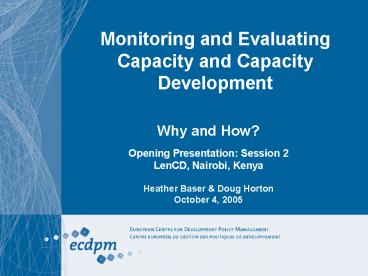Monitoring and Evaluating Capacity and Capacity Development - PowerPoint PPT Presentation
1 / 17
Title:
Monitoring and Evaluating Capacity and Capacity Development
Description:
Monitoring and Evaluating Capacity and Capacity Development Why and How? Opening Presentation: Session 2 LenCD, Nairobi, Kenya Heather Baser & Doug Horton – PowerPoint PPT presentation
Number of Views:95
Avg rating:3.0/5.0
Title: Monitoring and Evaluating Capacity and Capacity Development
1
Monitoring and Evaluating Capacity and Capacity
Development
- Why and How?
- Opening Presentation Session 2
- LenCD, Nairobi, Kenya
- Heather Baser Doug Horton
- October 4, 2005
2
Outline for the Presentation
- Purpose of the session
- General context of capacity development
- Characteristics of capacity
- Challenges for CD for ME
- ME purposes approaches
- Organization of the session
3
Purpose of this Session
- Challenge participants to think about
- Why how ME of capacity CD is different
- Tensions between ME for accountability
learning - Look at different ME approaches
- For accountability learning
- Quantitative qualitative methods
- Formal informal approaches
- RBM systems approaches
- Address some fundamental questions
4
General Context of CD
- Agreement on the importance of CD
- But are people talking about the same thing?
- Increasing sums being spent on CD
- But efforts are often poorly conceived managed
- Theory of change not well articulated
- TA main or even sole delivery mechanism used
- Public sector results disappointing
- Lack of knowledge of what works doesnt work in
CD
5
Characteristics of Capacity
- A property of human systems
- Multi-dimensional multi-level
- Capacity needs depend on context
- Many intangible, soft issues
- Cant be transferred, needs to be developed
- Often has short shelf life
6
Five Elements of Capacity
- Self-organize and act
- Create operating space relationships
- Develop implement a coherent vision strategy
- Continuously adapt renew
- Achieve development results
7
Challenges for CD
- Address political dimensions / empowerment
- Strengthen relationships social capital
- Develop flexible management systems to allow for
unpredictability of human systems - Balance short-term gains long-term processes
- Equip organizations to design facilitate
flexible CD processes
8
Challenges for ME
- Understanding links between capacity, CD
performance - Assessing progress against ill-defined,
intangible goals - Doing ME in a systems context
- Providing short-term measures in the context of
long-term processes - Rigorous studies of capacity CD are costly
- Absence of baseline data
- Engaging vs exhausting stakeholders?
9
Why Monitor or and Evaluate Capacity or CD?
- To meet demands for accountability results
- To donors
- To clients / beneficiaries
- To learn and improve practice
- Each of these purposes is legitimate important.
- But can one ME approach satisfy all 3 demands?
10
ME for Accountability to Donors
- The traditional type of ME
- Donors determine the evaluation questions
evidence to be used - External evaluators are the norm
- Evaluation standards are goal achievement value
for money - CD viewed as a project / programme intervention
- Emphasis on quasi-experimental designs,
quantitative indicators impact assessments
11
ME for Learning Improvement
- Newer type of evaluation, emerging out of OD
- Concerned with improving org performance
- CD viewed as a continuous, developmental process
- Legitimacy is gained through building consensus
- Evaluation questions and methods determined
internally (with aid of OD specialists/facilitator
s) - Internally managed (self) evaluation
- Emphasizes participatory, constructivist,
qualitative approaches
12
ME for Local Accountability
- Probably the most important, but least practiced
- Experience in NGOs
- Local stakeholders determine the evaluation
questions evidence to use - Local evaluators / facilitators are the norm
- Evaluation standard is delivery of useful
products services - CD viewed as local empowerment
- Primacy of participatory, qualitative analysis
13
Organization of the Session
14
Questions Framing the Session
- What are advantages disadvantages of different
approaches? - What is different about capacity that affects how
we approach ME? - How much time resources should we devote to ME
of capacity vs. performance? - How should the purpose of ME shape the approach
we use? - Who should define what to M or E and how to do
it? - What are the implications for the Paris
Declaration?
15
Four Working Groups
- Approaches for monitoring capacity and CD
- Approaches for evaluating capacity and CD
- Use of a soft systems approach
- Who should decide what to monitor and evaluate?
- Each Group has specific questions
16
Wrap-up Session
- Groups provide their answers to specific
questions - Discussion synthesis
- Discussion of the general questions
- Brief summary of key points closure
17
(No Transcript)































